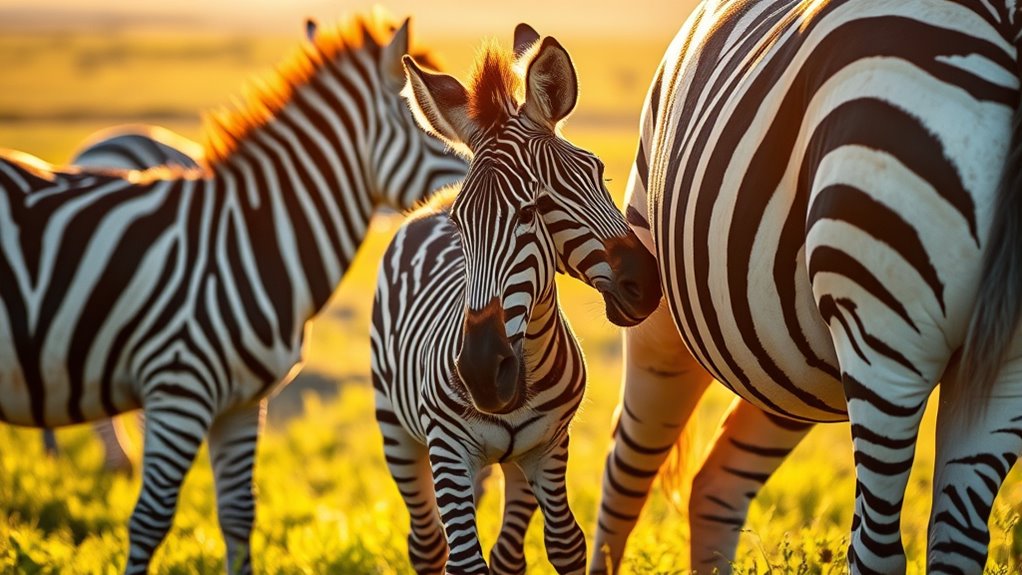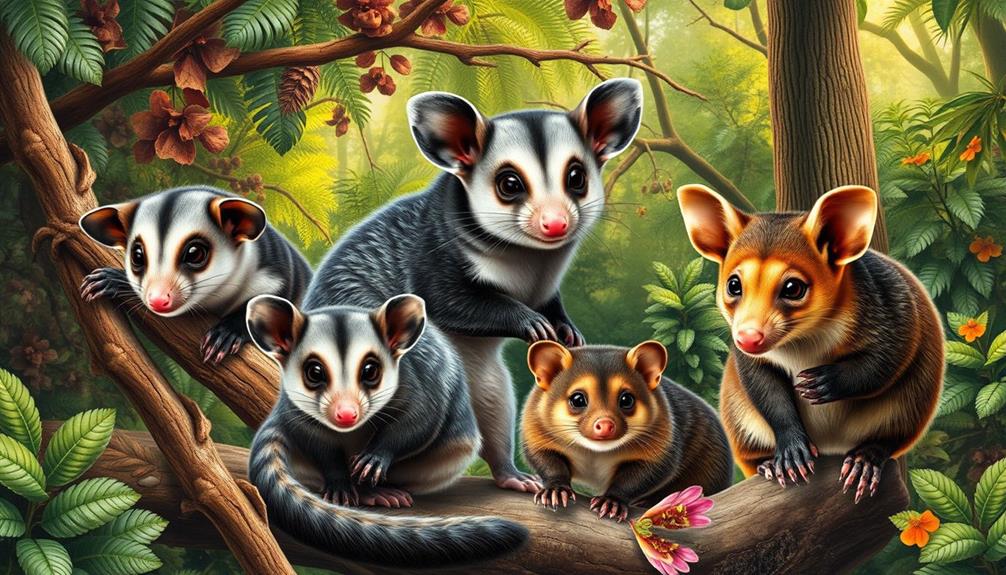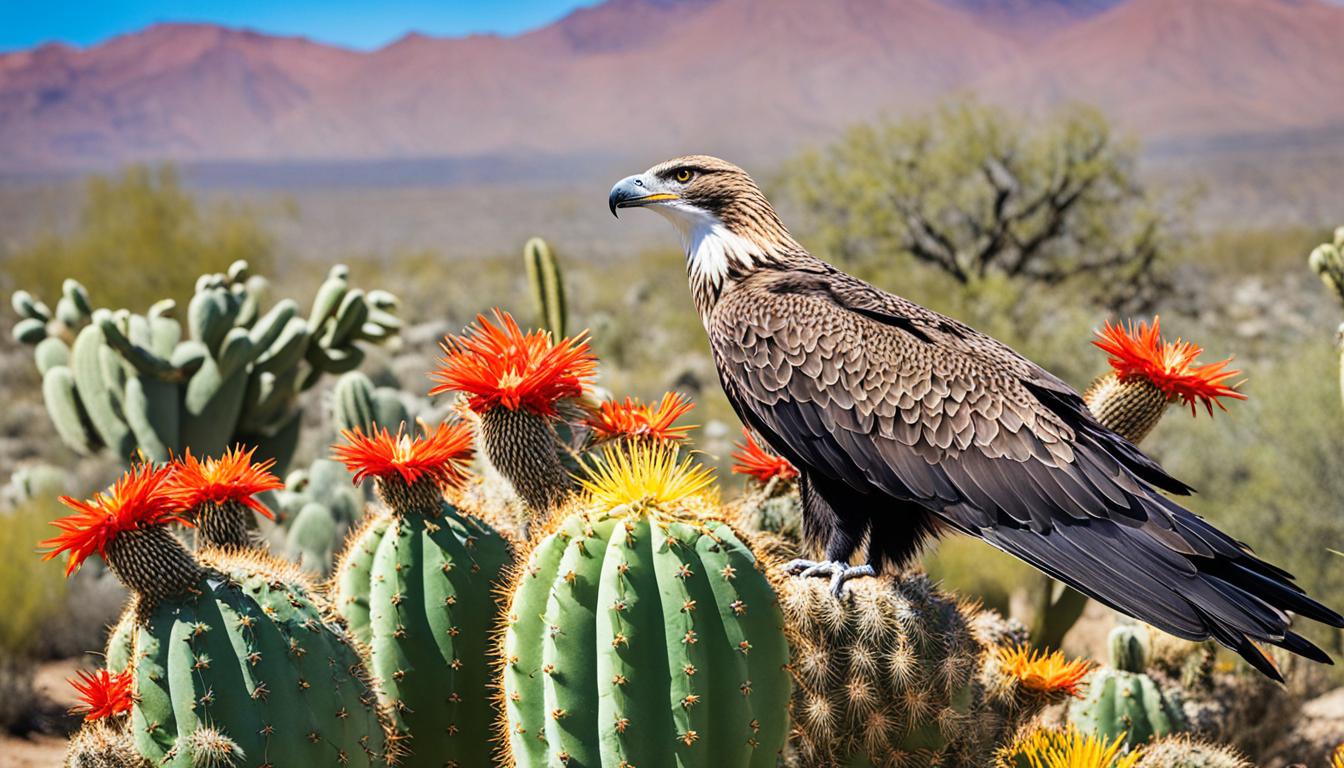Zebras have stripes mainly for camouflage, social signaling, and temperature regulation. Those stark black and white patterns confuse predators and help zebras recognize each other within herds. Stripes also assist in staying cool in hot environments. Each zebra’s unique pattern reflects its identity, strengthening social bonds. All these functions enhance their chances of survival. If you’re curious about how these stripes work in different environments, there’s plenty more to discover!
Key Takeaways
- Zebra stripes provide camouflage, confusing predators and breaking up their outline in groups, enhancing survival chances.
- Each zebra’s unique stripe pattern aids in individual recognition and facilitates social interactions within herds.
- The contrasting colors of stripes help regulate body temperature by absorbing and reflecting sunlight differently.
- Stripes serve multiple functions—camouflage, social signaling, and temperature regulation—making them essential for zebra adaptability.
- Overall, zebra stripes play critical biological roles beyond appearance, contributing to survival and social dynamics in the wild.

Have you ever wondered why zebras have stripes? It’s a question that many people ponder, and the answer involves a mix of fascinating theories. One popular idea suggests that these stripes serve as a form of camouflage. In the wild, zebras often graze in groups, and their stripes can create a visual illusion. When you see a herd moving together, the contrasting black and white patterns can confuse predators. The stripes break up their outline, making it harder for lions or other predators to single out an individual zebra. This clever use of camouflage patterns allows zebras to blend into their environment, increasing their chances of survival.
But camouflage isn’t the only reason zebras wear their stripes. Another important function is social signaling. When you observe a zebra’s stripes up close, you’ll notice that each one is unique, much like a human fingerprint. This individuality plays a significant role in social interactions among zebras. Their stripes help them recognize each other, allowing for stronger bonds within their herds. You might think of it as a way for zebras to communicate their identity and status. When they’re in a group, these stripes signal to others who they are and how they fit into the social structure.
Interestingly, the stripes may also play a role in temperature regulation. The black and white colors absorb and reflect sunlight differently, which could help zebras stay cooler in the hot African sun. This aspect doesn’t overshadow the camouflage and social signaling theories, but it does add another layer to the mystery of their stripes. Moreover, just like how SeaWorld operating hours can vary seasonally, the patterns and functions of zebra stripes can also change based on their environment and social dynamics.
In the end, it’s likely that zebras sport their stripes for a combination of reasons. Whether it’s to evade predators, communicate with each other, or manage their body temperature, these stripes are essential to their survival. Next time you see a zebra, take a moment to appreciate the complexity behind those striking black and white patterns. You might find that there’s more than meets the eye when it comes to understanding these remarkable animals. So, the next time you come across a zebra, remember that those stripes are not just for show; they’re a crucial part of the zebra’s life in the wild.
Frequently Asked Questions
Do All Zebra Species Have Stripes?
Yes, all zebra species have stripes, which evolved over time. You’ll find that these stripes serve various functions, including predator camouflage. When you see a herd moving, the stripes can confuse predators, making it harder for them to single out one zebra. Each species has distinct stripe patterns, but they all share this evolutionary trait, helping them survive in the wild. So, those stripes are more than just for looks!
Can Zebra Stripes Change Color Over Time?
Zebra stripes don’t change color over time, but environmental influences can affect how you perceive them. Factors like lighting, habitat, and even the zebra’s health can alter your view of their stripes, making them appear lighter or darker. However, the actual pigmentation remains constant. So, while it might seem like there’s a color change, it’s really just the surroundings playing tricks on your eyes!
How Do Zebras’ Stripes Affect Their Social Behavior?
Zebras’ stripes enhance their social behavior by promoting social bonding within the herd. The contrasting patterns help individuals recognize each other, fostering stronger connections. This unity can also deter predators; when zebras move in a group, their stripes create a confusing visual effect, making it harder for predators to single one out. So, those stripes aren’t just for show—they play a vital role in their social dynamics and survival strategies.
Are Zebra Stripes Unique Like Fingerprints?
Yes, zebra stripes are unique, much like fingerprints! This uniqueness stems from genetic variation, which plays a vital role in each zebra’s pattern. You might wonder, why does this matter? Well, these distinct stripes can offer evolutionary advantages, helping zebras identify each other, bond socially, and even evade predators. So, the next time you see a zebra, remember—it’s not just a pretty pattern; it’s a essential part of their survival strategy!
Do Any Other Animals Have Similar Stripe Patterns?
Yes, other animals have similar stripe patterns! For instance, tigers and certain species of fish also use stripes as camouflage strategies. These patterns help them blend into their environments, making it harder for predators to spot them. Just like zebras, these animals confuse predators with their unique markings. So, next time you see a striped animal, remember they might be using those stripes to stay safe and thrive in their habitats!
Conclusion
In conclusion, zebras’ stripes aren’t just for show; they’re essential for their survival. Did you know that studies suggest these stripes can reduce biting fly landings by up to 80%? This statistic highlights how evolution has equipped zebras with a unique defense mechanism. So, next time you see a zebra, remember that those striking stripes are more than a fashion statement – they’re a clever adaptation that helps them thrive in the wild.









